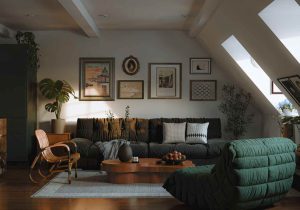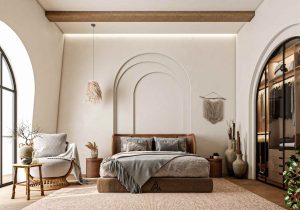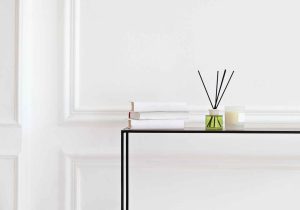Your dream home should be a space that engages your senses in every way possible. This requires designing spaces that are more than just visually pleasing, but also incorporate elements that engage your sense of sound, smell, and touch. Each of these elements work to elevate your experience in your home, turning it from a form of shelter to a haven of luxury and comfort. However, while sensory interior design can elevate your experience, the key is to strike the right balance between stimulation and over stimulation, especially when our lives today are a lot more demanding than they once were. Your home interiors should make you feel calm and relaxed at the end of a taxing day, taking away all your worries and giving you the chance to rejuvenate.

In this guide, we show you some of the best ways to enhance your home interiors through sight, touch, sound, and smell.
Designing spaces that stimulate your senses and make for a relaxing experience can be tricky, especially with the risk of going overboard. Additionally, there’s so much more to the world of sensory interior design than resources like Pinterest might let on.
The key to achieving the perfect home interiors is to strike the right balance between elements that engage each of your senses. The expertise of a skilled interior designer is key, as they’re experienced in designing spaces that leave you relaxed in the lap of luxury.
Your home’s interiors play a key role in defining how you feel when you enter your space. In fact, some studies show that people who are happy with their home interiors are happier in general. The impact of luxurious, comfortable, and sensorily appealing home interiors is thus evident.
A focus on sensory interior design helps us create spaces in a manner that makes us feel a certain way, be it relaxed, cosy, or even peaceful. The key is to design interiors that don’t overstimulate or make you feel uncomfortable, but calm and relax you, especially in the case of neuro-diverse individuals.
There are several different things you can do to make your home interiors sensorily stimulating. This section explores some of these tips to give you a blueprint that you can take inspiration from.

When it comes to engaging your sense of sight, choosing the right colour palette for your interiors is crucial. Whether you’re someone who prefers cooler or warmer tones, or even earthy tones or more vibrant, eclectic options, the key is to find the right balance to ensure your space doesn’t overstimulate you.
For instance, if you prefer interiors that are bright and eclectic, you can incorporate colour in furnishings like cushions, rugs, throws, curtains, and more. However, to balance these out, you can choose a sofa set in a neutral shade like a beige, off-white, or even a light brown. While white also makes for the perfect base for a dash of colour, keep in mind that a white sofa set will require more maintenance to keep it looking clean over time.
Just as the colours you choose are important, the lighting in your space can also make or break your interiors. Lighting adds a sense of depth and character to your home’s interiors, making it crucial that you choose the right colour temperatures based on your home’s colour palette. While warmer colours work well for spaces like living rooms and bedrooms, kitchens, for instance, are best suited to cooler lighting.

Touch is a powerful sense that often gets overlooked when it comes to interior design. However, it can go a long way in enhancing your senses when you spend time at home. One of the best ways to do this is to choose textures that are warm and inviting. You can incorporate these textures in your sofa sets, cushions, rugs, and other furnishings.
In fact, your furniture too can incorporate a whole range of different textures. For instance, different species of wood feel different to the touch, aside from variations in their appearance, grain, and colour.
Similarly, you can incorporate textures in spaces like your bathrooms using unique, statement tiles, in your bedroom using the materials used to make your bed frame, aside from every other room in your home.

Sound plays a key role in shaping our perception of our homes’ interiors. Whether you want a space that’s acoustically sound or one that relax and calm you, there are several things you can do to stimulate your sense of sound in your home.
To make your interiors acoustically sound, you can opt for plenty of soft furnishings like plush sofas, curtains, rugs, cushions, and more. These help absorb sound and can make your media consumption a lot more pleasing. They can also minimise echo when having conversations, making your interiors better suited to hosting large gatherings if needed.
Introducing water features in your home is another way you can add to your home’s sensory interior design. Be it inside your home or in your balcony, the calming sound of flowing water can help make your interiors a lot more relaxing.

Stimulating your sense of smell using aromatherapy is a key aspect of sensory interior design that’s also overlooked in most cases. Your olfactory senses can play a key role in evoking a sense of peace and calm or even older memories, making your space a paradise to spend time in.
You can consider using scented candles, essential oils via aromatherapy diffusers, or even fresh flowers to enhance the olfactory pleasure of your home’s interiors.
Spaces like bathrooms and kitchens should also be catered to, with scents that complement your tastes and preferences, along with the intended use of these spaces.
Incorporating sensory interior design to create a relaxing and opulent space can be tricky, especially with the risk of going overboard. However, this guide has listed some of the best ways you can design your interiors to stimulate your senses of sight, touch, smell, and sound.
If you’re looking to design the interiors of your new home from scratch, it’s always best to work with an experienced interior design firm. Bonito Designs is India’s only ISO-certified full home interior brand, making it the best suited to creating opulent spaces with the best practices in mind.
Reach out to us today to experience the magical world of interior design.